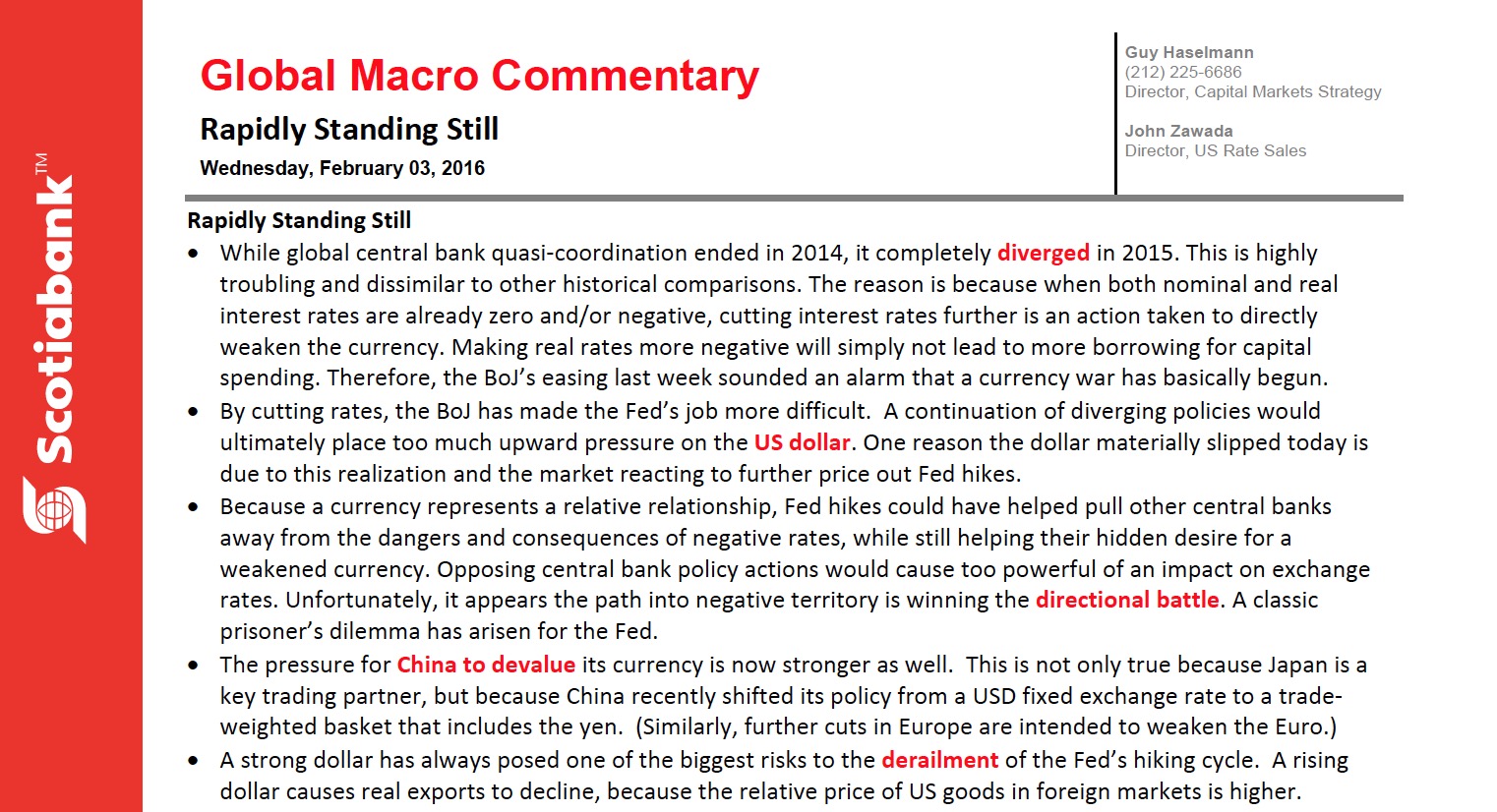Rapidly Standing Still
by Guy Haselmann, Director, Capital Markets Strategy, Scotiabank GBM
• While global central bank quasi-coordination ended in 2014, it completely diverged in 2015. This is highly troubling and dissimilar to other historical comparisons. The reason is because when both nominal and real interest rates are already zero and/or negative, cutting interest rates further is an action taken to directly weaken the currency. Making real rates more negative will simply not lead to more borrowing for capital spending. Therefore, the BoJ’s easing last week sounded an alarm that a currency war has basically begun.
• By cutting rates, the BoJ has made the Fed’s job more difficult. A continuation of diverging policies would ultimately place too much upward pressure on the US dollar. One reason the dollar materially slipped today is due to this realization and the market reacting to further price out Fed hikes.
• Because a currency represents a relative relationship, Fed hikes could have helped pull other central banks away from the dangers and consequences of negative rates, while still helping their hidden desire for a weakened currency. Opposing central bank policy actions would cause too powerful of an impact on exchange rates. Unfortunately, it appears the path into negative territory is winning the directional battle. A classic prisoner’s dilemma has arisen for the Fed.
• The pressure for China to devalue its currency is now stronger as well. This is not only true because Japan is a key trading partner, but because China recently shifted its policy from a USD fixed exchange rate to a trade-weighted basket that includes the yen. (Similarly, further cuts in Europe are intended to weaken the Euro.)
• A strong dollar has always posed one of the biggest risks to the derailment of the Fed’s hiking cycle. A rising dollar causes real exports to decline, because the relative price of US goods in foreign markets is higher. Concurrently, foreign goods are cheaper to US consumers, so real imports rise in the US. US slack increases as domestic production declines, resulting in lower GDP and lower prices. In other words, global output becomes redistributed away from the US.
• Currency wars are a zero sum game. However, they can be a negative sum game if they lead to protectionism or other anti-globalization retaliatory measures. Currencies are targeted when there is a deficiency of good or effective policy options. Unfortunately, Japan, China, and Europe cannot all become more competitive against each other at the same time, and attempts to do so destabilize markets and propagate imbalances.
• Stanley Fischer is one of the most experienced and wily central bankers in the world. His shrewd insights are influential. Many on the FOMC (and elsewhere) look to him as a ballast and beacon for navigating highly turbulent financial markets and economic waters. His calm and unflappable demeanor shrouds a deep understanding of economic and financial market issues, and the first and second-order effects of monetary policy.
• It is interesting and no coincidence that several of his recent speeches have addressed exchange rates and risks to financial stability (see here and here). In an interview with Tom Keen on Monday, he commented at length on the question of currency wars. Fischer said to Keene, “The agreement is that the international body of policy makers frowns upon measures undertaken solely to weaken a currency….if you are trying to change the exchange rate purely to get an advantage against other countries, that’s not ok”. Fischer sounded as if he was warning other central banks. (My colleague Dov Zigler wrote an excellent note on this interview: see here)
• Risks to financial stability, which are intertwined with the level of the USD, likely played a role in the Fed’s decision to hike rates in December. Political aspects, which some FOMC members are only willing to admit in closed door meetings, also played a part. Congress generally views interest on excess reserves as an unpalatable ‘giveaway of taxpayer money to banks’. Ironically, a 0% rate is also criticized.
• The Fed has a tricky balance of trying to find (and not veer too far from) the ‘neutral rate’, while simultaneously managing an enormous balance sheet and restraining as much political opposition as possible. In this regard, putting some distance between 0% and the Fed Funds rate therefore has its benefits, as both negative rates or a QE4 program (should it be necessary) would be highly problematic from a political point of view. Although the argument might sound stupid, by lifting rates, the Fed has the ability to move back down to 0% before resorting to these other ‘contemptuous’ actions. The FOMC is certainly in a quagmire.
• As I have been writing for over a year now, “all roads lead to Treasuries”. I have outlined the many reasons on numerous occasions. I still expect long-dated Treasuries to be one of the best trades of the year. I expect them to move to new all-time low yields in 2016 (i.e., 10’s and 30’s below 1.39% and 2.23% respectively).
“They disguise it. Hypnotize it. Television made you buy it.” – System Of A Down
Regards,
Guy
Guy Haselmann | Capital Markets Strategy
▬▬▬▬▬▬▬▬▬▬▬▬▬▬▬▬▬▬▬▬▬▬▬▬▬▬▬
Scotiabank | Global Banking and Markets
250 Vesey Street | New York, NY 10281
T-212.225.6686 | C-917-325-5816
guy.haselmann[at]scotiabank.com
Scotiabank is a business name used by The Bank of Nova Scotia
Copyright © Scotiabank GBM
Read/Download the complete report below:















